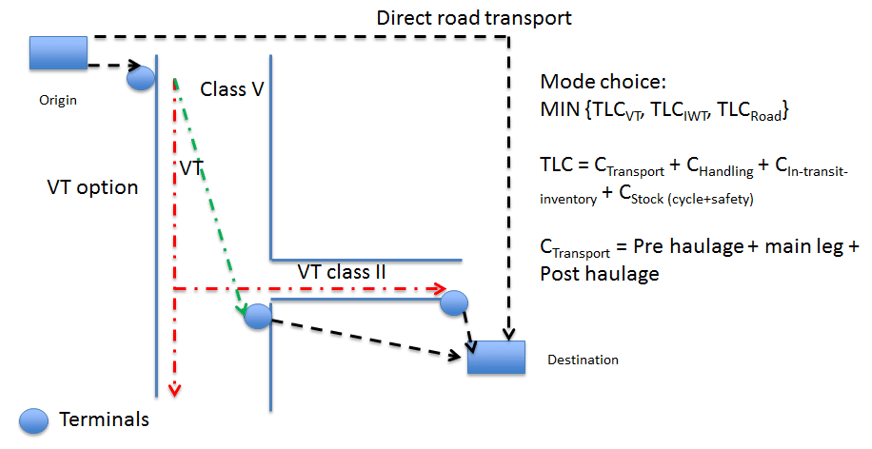NOVIMAR TRANSPORT MODEL
The transport model will include the following main elements:
- Transport network
- Different origins and destinations (ODs) in the “Antwerp” case study area
- Fine mesh in the region around the Port of Antwerp
- A less fine mesh for cargo flows going to the Rhine
- Inland terminals in the different hinterland areas
- Location of urban areas in the different origins and destinations
- Sea ports with the different container and RoRo terminals.
- Different origins and destinations (ODs) in the “Antwerp” case study area
- Modes of transport (including intermodal transport)
- IWT
- Current IWT vessels
- VT concept
- Road
- Rail
- Sea-River
- Current SR vessels
- VT concept
- Shortsea
- Current SSS vessels
- VT concept
- Logistics cost components:
- Out of pocket Cost
- Time
- Inventory cost
- In transit inventory cost
- Value of time and depreciation cost of cargo
- IWT
The transport model has the following data needs:
- Cost data of all modes (the starting point of the cost structures will be taken from van Hassel et al. (2016)) and will be updated in the course of the Novimar project with the help of the project partners.
- Cargo-related data (depreciation and value, data from project partners).
- The transport network and transport modes are also taken from van Hassel et al. (2016), which will be updated and adopted to the needs of the Novimar project.
The transport model is schematically given in the following diagram:

For a business-economic assessment, two levels are taken into account.
- The first assessment will simply measure whether there is a cost advantage for the ship-owner/operator when using the VT concept instead of traditional individual sailing. If the cost savings turns out to be positive, then the VT concept leads to a lower cost per transported unit and the VT concept will be successful from a business-economic point of view. If the cost savings is negative, then the VT concept will lead to higher cost per unit which will make that it is not worthwhile for the ship-owner/operator to shift to a VT system. If a third party is organizing the VT and operating the lead vessels, then also these costs need to be taken into account. These will be transferred to the vessel owners who will pay for using the service to be in a VT.
- The second level of assessment is related to the size of the waterborne freight market. This size of the waterborne freight market is determined by the modal share of waterborne transport. This modal choice is determined based on the total logistics costs (TLC) incurred by the shipper/owner of the goods. If the TLC for a cargo owner will decrease, there is a gain for the cargo owner. If the TLC will increase, there is a cost increase for the cargo owner. Therefore, if the cost reduction is negative, then there is no incentive for a modal shift. For a decrease in TLC, even very small, there is an incentive for a modal shift from the cargo owner.
